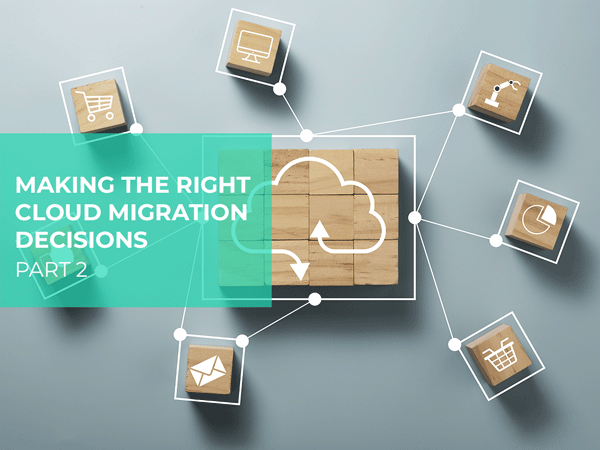Making the right cloud migration decisions

In the first installment of this series I introduced the key cloud transformation approaches and the organizational concept of the cloud center of excellence. We now dive deeper into how to actually execute cloud assessments to give you the key insights to succeed in your cloud transformation projects.
Application Discovery & Cloud Assessment
In order to answer the questions around cloud readiness, risk, costs and cloud added value, application information has to be collected at first. In this discovery phase, data about applications and their infrastructure is collected, which should then evaluated using a cloud assessment rule set. Tools can support you in the structured and centralized collection of data. Our platform Txture is especially strong in this area. A detailed description of best practices for data collection would unfortunately go beyond the scope of this article.
Therefore I come to my second recommendation regarding cloud assessment before we go into the individual perspectives of cloud readiness.
When making assessment and migration decisions, don't just focus on technical feasibility and migration effort. Instead, place more emphasis on the cloud added value that can be created.
In practical terms, this means when analyzing applications, you should not only look at the technical stack (servers, databases, etc.), but, just as importantly, at the business, security and compliance requirements at the application level.
You should develop a rule-based approach with your CCoE that takes these aspects into account when evaluating applications. In this way, you create a uniform methodology and cloud migration decisions can be better argued and made faster.
In the following I will discuss the most important aspects that should be part of your rule-based assessment approach. Let's start with cloud readiness.
Cloud Readiness
Cloud readiness refers to the suitability of an application including its technical components and their configuration for the cloud. A typical example is the degree of virtualization of an application. For example, does the application run entirely on virtual machines or is it already containerized? If so, this naturally increases the feasibility of cloud migration and reduces the effort involved. If it runs directly on physical servers or a mainframe, then this makes migration significantly more complex or even impossible.
Cloud readiness has many additional facets, which I would like to outline in the following list.
- Are there actually matching cloud services for the application components that could replace them?
- Which applications communicate with a specific application and is this communication encrypted? Unencrypted communication would probably have to be encrypted when moving to the cloud, which in turn would increase the migration effort.
- Does the code of an in-house development use hard-coded IPs? This would also lead to higher migration effort.
- Are the components stateless and therefore potentially suitable for containerization?
This is of course only a small selection of important questions. I advise you to adapt questions to the specific technical requirements and standards in your company.
Another important aspect besides the technical feasibility is the migration risk.
Cloud Migration Risk
With regard to migration risk, one should consider the general, but also the industry-specific regulatory requirements. The main focus lies on the issues surrounding the processing and transmission of data, but also, of course, on the criticality of individual applications. For example, with regards to business continuity. So at the very least, include the following questions in your assessment ruleset.
- Which data is processed or transported by an application? Is it personal data or important intellectual property?
- Is it personal data that, for example, may not leave the EU for regulatory reasons (e.g. because of GDPR)?
- Are there special certification requirements from your industry sector that you need to consider? Which cloud provider has the necessary certifications? Also consider that certification is typically per data center location. So the actual certification of the technically same service varies by data center!
- How many users does the application have and what would be the consequences of a failure during a migration?
The migration risk is, of course, always in proportion to the added value of cloud migration and the expected costs. We consider both of these next.
Cloud added value and business case
As mentioned at the beginning, the cloud added value should always be the focus of your analysis. Even if an application would be technically very easy to migrate and has a low migration risk, this does not necessarily mean that it makes sense to migrate the application.
In addition to the cost savings potentials, which I discuss below, there are several other important factors that contribute to the cloud added value. These include, for example:
- Does the application benefit from the horizontal and vertical scaling options in the cloud?
- Would the migration additionally power your organization’s ability to innovate?
- Can we reduce administration effort by using PaaS or SaaS products?
- Has the application already reached its utilization limit and would an infrastructure investment be needed anyway?
- Does the application use technologies that do not meet the technology requirements of your strategy or is no longer supported?
In addition to the non-monetary cloud added value, one should of course make the most accurate comparison possible on an actual cost level. I would like to point out another important recommendation here, because costs are more complex in cloud migration than they appear at first glance.
Consider at an early stage how and where you can save costs on your journey to the cloud in order to make the migration a long-term success on a financial level as well.
Much has already been written about how you can save costs when you are already in the cloud. This is of course important, but if you start optimizing early on, the benefits of the cloud can be demonstrated more quickly.
Please note the following points to achieve savings at an early stage:
- In the course of the assessment, look for possibilities to consolidate applications and to consistently shut them down. An assessment is a good time to discover and resolve redundancies.
- Before the migration, consider making commitments about cloud service usage. Through these so-called "Reserved Instances" you can achieve strong discounts with the cloud providers.
- Do a "right-sizing" analysis before you migrate. This allows you to achieve optimal utilization of cloud resources and increases your cost savings potential early on in the migration.
- Consider PaaS, FaaS, CaaS and SaaS rather than IaaS. This will reduce the administrative effort of the infrastructure. Simple "lift and shift" of the infrastructure has its justification, but mainly when speed is the absolute goal, e.g. in carve-outs or data center breakups.
When calculating your cloud business case, you should also keep the cost of inbound and outbound traffic from the cloud data centers in mind. In practice, we often observe that these costs are ignored because they are not as obvious as the actual operational costs of cloud services. In this case, it is important to pay attention to the fine print of your cloud provider.
Where and how to get started?
I hope these tips will help you to move faster from cloud strategy to the actual transformation.
The starting point for the assessment and your decisions should always be your cloud strategy, which is driven by the Cloud Center of Excellence. Of course, the strategy must not be set in stone and must continuously adapt to the organizational, technical and market-related conditions.
You should also set up a CCoE as early as possible to analyze the assessment of your application landscape from the perspective of your specific business, security, compliance and technical requirements. In doing so, focus primarily on the cloud added value at the application level rather than on technical feasibility and start cost optimization early on, before the first unexpectedly high invoices arrive.
And last but not least, use tools that accelerate your cloud transformation and reduce costs through best practices and automation.
I wish you every success on your journey to the cloud.
Do you want to know more about Txture's Cloud Transformation Platform and want to discuss how Txture can facilitate the cloud journey of your organization? Get in touch and book your free demo session with me!
Related posts
14.11.2023Cloud MigrationSecurity risks of cloud computing11.5.2023
Modernization StrategyModernizing legacy IT applications30.3.2023
Cloud Migration Cloud Migration Overview | The 4 Phases & Best Practices6.12.2022
Cloud Target ArchitectureCloud Transformation: how to define the right cloud solution architecture16.11.2022
Cloud AssessmentReady, set, cloud: What is a cloud readiness assessment?
